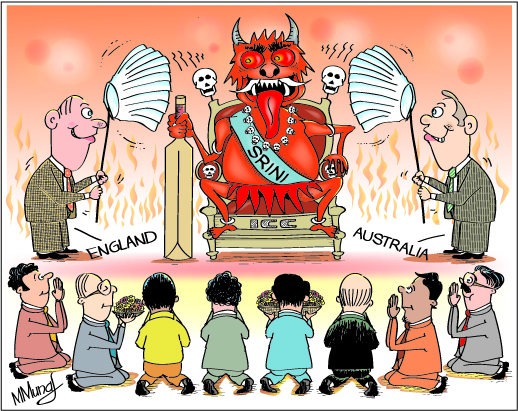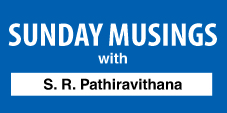Walk with conviction; hot coal does not burn
View(s):The common dislike towards the ‘Big Three’ concept in world cricket administration is taking deep root among the game’s fraternity. The mannerisms of the Big Three on how they have treated the ‘rest’ in the recent past are becoming a huge concern to the fraternity now.
The ‘Big Three’ have not only bent the aspirations and the common goals of the cricket community, but are also beginning to treat the rest of the community as subjects. Now even the ICC mechanism is eager to toe the line of the Big Three on a priority basis.
The two incidents involving the Lankan off spinner Sachithra Senanayake occurred only a week ago. But, by last Tuesday, the ICC Cricket Committee had discussed the issues of running out a batsman at the non-strikers end and about the bowlers operating with bent arms.
From 1957 to 1964, left arm fast bowler Ian Meckiff represented Australia and once helped his country take home the Ashes. Meckiff was accused of operating with a bent arm by the opposition, but, the Australian selectors thought his action was good enough to bowl at international level. Meckiff’s international career came to an end when he was called by Australian umpire Colin Egar. Yet, Meckiff’s international career lasted for a considerable period.
Nevertheless on that same soil in the 1995 Boxing Day Test, Lankan spinner Muttiah Muralitharan was no-balled by Australian umpire Darryl Hair. However, it was not the ‘Big Three’ blanket rule era. The Lankan cricket administration fought the case and proved that he had a born deficiency in his arm structure and he was not throwing in the process of the delivery of the ball. The ICC passed a tolerance rate of 10 degrees for fast bowlers, 7.5 degrees for medium pacers and 5 degrees for spinners.
Yet, many did not buy the lab testing. Murali bashing became an international passion. Then to address the Murali issue the ICC went into action and tested around 130 reputed international bowlers’ actions at random. There they were astounded to discover that most of the bowlers — the ones who had no problems with the umpires had bent arms beyond the stipulated amount. Most of them were operating with arms that bent 8-10 degrees.
So the ICC formed an expert panel comprising biomechanics Professor Bruce Elliott of the University of Western Australia, Dr Marc Portus of the Australian Institute of Sport and Dr Paul Hurrion from Britain. At a special ICC cricket sub-committee forum for illegal bowling actions in late 2003 in Dubai, they presented their findings. The sub-committee comprised David Richardson (South Africa), Angus Fraser (England), Aravinda de Silva (Sri Lanka), Michael Holding (West Indies), Tony Lewis (England) and Tim May (Australia). After this meeting, the ICC decided to raise the elbow extension tolerance threshold to 15 degrees for all bowlers.
That was the Murali saga. Like we discussed last week, now Senanayake’s action had come under scrutiny and he is under examination at the Cardiff Metropolitan University, Wales.
 Why? England, a member of the ‘Big Three’, found it difficult to face Senanayake.
Why? England, a member of the ‘Big Three’, found it difficult to face Senanayake.
Bowlers like Shane Shillingford, Marlon Samuels and Johann Botha have been reported in recent times, but none of the incidents involving these bowlers did stink so much.
At Present, the Sri Lanka-England first Test is going on. Thereafter there will be another one. Yet, in the latter half of the English summer India – the new Sultan of World Cricket — will play five Tests. That’s how the Big Three formula works.
While the World T-20 Cricket Championships were going on in Bangladesh in March-April, the Indian cricket administration was shaken to the core by the scandal involving BCCI President N. Srinivasan.
The Justice Mudgal committee which is probing into the IPL-6 spot fixing scandal has made various recommendations, but has not barred the beleaguered Srinivasan from taking up post at the ICC.
Yet, the ICC which acts as the paragon of virtue in the cricketing world (if the paragon really knows the meaning of virtue is) has adopted an eerie silence on the Srinivasan issue, though it was double quick to jump the gun on the Senanayake issue.
The NDTV reported Indian Cricket Board secretary Sanjay Patel as boasting, “By the month end, India will take a leading role in the ICC. Mr. Srinivasan is going. There is no Supreme Court bar on him. Both of us are going to Melbourne. In the last four months we have settled (the issue) with all the full members of the ICC and convinced them about the new structure and the new financial model of the ICC which would be followed in the coming years”.
This is where the wound lies. As things occurred in the ICC revamp, the Big Three is in control. No one could argue on that point. But, the International Cricket Council is the International Cricket Headquarters. That is the hallowed icon of world cricket where many nations are trying to become associate members or full members. It is the organisation that has to be dressed in impeccable white. It cannot afford to have any dirt or even a cobweb hanging from its attire.
In cricket, the biggest blasphemy is betting, bookies and match fixing. The IPL-6 fixing scandal is just that, where even an Indian National cricketer in the calibre of Srisanth had bid adieu to his future beyond the boundary line.
Then Meiyappan Gurunath – the son-in-law of N. Srinivasan who has admitted the felony, was a leading member of Srinivasan-led Chennai Super Kings. The Mudgal Committee still has not given the green light saying Srinivasan is innocent. Just say on June 25 Srinivasan does take over the reins of the ICC and a subsequently if he is found guilty by the Mudgal Committee. What would be the plight of the entire ICC?
Clearing the decks for his election as the first chairman of the new-look International Cricket Council (ICC), the Indian Supreme Court on Thursday declined to hear Cricket Association of Bihar’s plea to restrain ousted BCCI chief Srinivasan from participating in the polls slated for June 27. Srinivasan is all set to become the chairman.
Yet, he has not been cleared by the Mudgal probe. Still the hatchet is hanging over his head. Is that the quality of people that the ICC needs?
Once when Lankan gaming baron Thilanga Sumathipala was eyeing an important ICC position, I could remember how the cricket entity reacted. If the reaction for the inclusion Sumathipala is such, why the ICC takes a firm stand and say, “We would consider Srinivasan only after he clears his name?” Is the World’s leading cricket body so gutless?
Isn’t there one cricket boss in the world who has the guts to come out and urge the ICC to take a just stand that would preserve its good name and image or doesn’t it matter?
If this is the real status quo in World Cricket, I feel pretty low myself and also feel sorry for the game that we have loved for so long.
There are mundane people who walk over hot burning coal at places of worship I have seen. That is because they have a conviction that they are doing the right thing by the god they believe in. This is not hot coal, but, if the plea for the right thing misfires the consequences may be terrible. Or is it that on that sunny morning in Singapore, persons who were against and then made to say yes were treated by the big boss.


